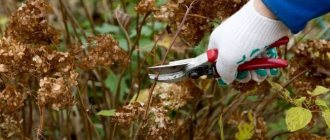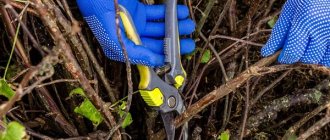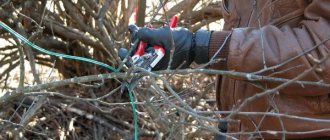Sometimes nature presents us with such temperature changes, with sudden frosts down to -20 and prolonged thaws. Any, even the most frost-resistant varieties, cannot withstand such changes. But most often roses die not from freezing, from damping off, and it’s all our fault, we hope for a mild winter, for varietal resistance to diseases. But everything happens much simpler.
Most of our garden roses have southern species as distant ancestors and they simply do not know that by winter they need to shed their leaves and go to sleep. They do not have a so-called state of rest. And with improper preparation for winter, and even with temperature fluctuations, they either fall into “hibernation” or awaken, which is why fertile conditions appear for the proliferation of fungi and bacteria, which can destroy roses over the winter.
Caring for climbing roses in autumn
The climbing rose, like other open ground plants, completes its growing season in the fall, but preparations for winter should begin in mid-August.
Preparing for the winter of a climbing rose and caring for it in the fall includes:
- Fertilizing with nitrogen fertilizers is stopped in August. Because they stimulate the active growth of greenery;
- in September, stop additional watering of the plant and loosening the soil;
- at the end of September, a dose of phosphorus-potassium fertilizer is introduced into the soil to strengthen the root system and above-ground parts of the plant.
When preparing roses for winter, you need to thoroughly clean the bush. All buds, flowers, leaves, damaged and broken shoots must be removed from it.
In Siberia
Considering that winters in this region are harsh, you need to cover a climbing rose for the winter in Siberia at the end of September. In addition, the first severe frosts come sharply, immediately after the end of the short summer, so it is important to fully protect the plant.
Note!
The most appropriate shelter option is a frame one, since winter here lasts long enough, which is why the roses wither and die.
But heavy snowfalls in Siberia can be considered a big plus. They will create a “warm blanket” effect, so the roses are unlikely to be affected by frost. Snow should be poured onto the bush as a snowdrift, immediately after precipitation falls.
Trim value
Climbing roses can be of various types, depending on which the most convenient pruning method is determined. In order for the procedure to benefit the capricious plant, it must be pruned regularly in the fall.
Preparing a climbing rose for winter necessarily includes pruning, which is needed for:
- removing old lashes;
- complete rejuvenation of the bush;
- thinning the bush in order to create its uniformity;
- lush flowering next summer;
- complete distribution of nutritional components from the above-ground part of the plant to the underground;
- increasing protective qualities and activating resistance to various diseases and pests;
- provides high-quality material for division.
Attention!
When pruning in autumn, you can shape the desired direction of the rose branches. If the bush is not pruned for 2-3 years, it will begin to get sick often, bloom less, and after 5-7 years it will completely die. Novice gardeners are often afraid of harming the plant by using complex pruning methods, but there is a solution. To start, you just need to reduce the height of the bush by about half or more and remove all old and damaged shoots at the base. Simple pruning will help renew the bush without any risks.
Choosing material for shelter
Let's consider the most popular types of materials for insulating roses:
- Geotextiles. A modern material, originally created for the construction industry, thanks to its dense structure, it has taken a place in gardening. In winter, it protects plants from pests, frost, and mold. The advantages are strength, ability to pass air and moisture. It promotes the evaporation of excess condensate and is affordable. To cover roses, you should choose geotextiles with a density of 200 g per square meter. In addition, it is easy to cover a climbing rose on an arch with geotextiles for the winter.
- Dry leaves or spruce branches. In the autumn, getting this material will not be difficult. Considered one of the best and most reliable. Environmentally friendly material, protects plants from winds, frost, sleet and freezing rain. Such shelter not only protects from winter cold, but also creates good ventilation, which allows roses to breathe.
As a covering material, you can choose plywood, lutrasil, burlap, old rags, blankets, coats, jackets, boards, roofing felt and other unnecessary things.
Pruning for winter
Ordinary bush roses are pruned according to the principle - the lower, the better. In the case of climbing roses, this technique does not work. A cut in the wrong place will cause a lag in the development of the plant, a decrease in decorativeness, stretching of lashes, late flowering or its complete absence.
Winter pruning is carried out after the night temperature drops to -3 degrees. In central Russia this happens at the end of October or beginning of November. If pruning is carried out earlier, the growth of new shoots is possible, which will certainly die in the winter. Some novice gardeners try to prune at the end of summer, but this is wrong. The plant will not have time to become lignified before frost and will die; after warming, the resulting rot will become a breeding ground for bacteria.
For areas with severe frosts
Hilling
The bottom of climbing rose bushes, as well as its root system, needs the most reliable insulation. You can cover this part of the plant with soil, mixtures (for example, soil + peat), pine needles, sawdust or some kind of fertilizer (humus, compost, the same peat), which is even better. The appropriateness of the choice depends on the specifics of the soil on the site, and taking this into account, it is not difficult to make the right decision.
Shelter with a "dome"
- Lay insulation (tar paper, burlap), and cover the top with old branches or spruce branches.
- The next layer is a polyethylene film, the edges of which are fixed to the ground with bulk earth or something heavy (cuts of metal pipes, bricks, etc.).
Differences in pruning depending on variety
Pruning recommendations vary depending on the “queen of the garden” variety:
- Early flowering varieties - Excelsa, Dorothy, Perkens. The affected roots are removed from the purchased seedling and all stems with a length above 30 cm are removed, shortening them. Immediately after flowering, long shoots grow from the bush. Which you need to try to form horizontally. The next year, vertical shoots are formed on horizontal shoots, strewn with buds. Flowering shoots need to be removed this year. A climbing rose bush can be called fully formed at 2-3 years.
- In plants of the second group, root shoots are poorly formed, so old ones are removed only after new ones have formed. After purchase, dry roots are removed from the seedling and long stems are removed. In the second year, the plant opens buds on young shoots.
- A group of roses with long, flexible stems. They bloom on last year's shoots. Care involves pruning the plant after flowering; the cut should be made into 2-3 buds. Side shoots need to be tied, weak ones should be removed - the plant will not bloom on them.
- Pyramidal with vertical growth. After purchase, weakened and damaged shoots are pruned and the root ball is reviewed. Healthy stems are supported. After flowering, side shoots with buds are cut to the ground. The following year, flowers bloom on the side shoots of the previous year; after flowering, they are cut to a length of 15 cm at the base.
- Vigorous, powerful bushes with shoots up to 6 m long. Formed horizontally and vertically. Old shoots are pruned annually. Side shoots are removed selectively.
Following the correct pruning rules will allow you to get lush blooms and see the rose weaving and growing quickly next season. The main condition for ensuring the successful completion of the procedure is temperature conditions and proper wintering.
Feeding after autumn pruning
The last time during the season the rose bush is fed after pruning, but you need to wait about 2 weeks until the plant’s condition stabilizes. If nitrogenous fertilizers are used for regular feeding in the summer, then after the buds open, this component must be removed from the nutrient mass. It stimulates the growth of flowers and shoots. In the fall, it is better to apply fertilizing with a high content of phosphorus and potassium - such products strengthen existing shoots. But they stop the growth of new ones and do not provoke flowering.
Important!
After the last autumn feeding, the tops of the stems need to be pinched - this will speed up the process of lignification of the main stem.
Since the plants are weakened in autumn, it is recommended to apply mineral fertilizer to moist soil in the evening after sunset - such conditions will help the queen of the flower garden go into winter rest smoothly and without injury.
Necessary equipment for pruning
For pruning you need the following set of tools and devices:
- pruners of different sizes and strengths - for large, old branches you need a massive one;
- folding saw, with the ability to change the angle of the blade;
- pruning shears with one cutting end;
- Teflon gloves (long);
- folding rakes.
For convenience, you can buy knee pads. They are made from different materials. They can be called an indispensable thing for working in the garden.
Secateurs of different sizes are necessary for accurate work. It is difficult to grab and cut without damaging a large branch with a small device. Working with young shoots requires caution, so it is better to use pruners with a thin blade.
When to prune
When considering the pruning process, it should be mentioned that climbing roses can bloom on last year’s or young branches. This is the main condition that is taken into account when caring for a plant. Ramblers produce color only on last year's branches, so they are pruned in the fall after the vegetative cycle has completed with flowering. Dry inflorescences must be removed.
Climbers bloom on young branches that are no more than 1 year old, so pruning is recommended in early spring after the air temperature during the day and night stays at around +2 degrees. Pruning at a time when night frost is possible is unacceptable, the frost will “grab” the cuts and they will not produce growth and flowers. An equally dangerous problem is rot, which is formed as a result of fungal infection, therefore, after formation, the plant must be treated with a fungicide.
Gardening tips
- Don't cut roses too short. It is imperative to clarify which group the plants exactly belong to, otherwise they may not bloom next year.
- You can’t wrap roses too tightly; a strong frame is enough to create a cushion of warm air.
- Do not feed plants only with potash or phosphorus fertilizers in the hope that they will overwinter better. Use nitrogen.
- Rose branches should be bent in warm and dry weather.
- In order not to harm the root system, there is no need to hill up the shrubs too much.
- When choosing a material, it is better to avoid plastic film; it disrupts moisture and air exchange.
There is no universal method for covering roses for the winter. Each gardener himself determines a reliable method, specifically for the conditions of his site.
Preparing a climbing rose for winter
Climbing roses have long shoots that are covered with sharp thorns along their entire length - this condition complicates the process of covering the plant for the winter, so they need to be pruned. A mistake that novice gardeners make is pruning at the root. This action results in no flowering the following year. The bush will be forced to grow new shoots and gain strength. The loss of all above-ground mass is detrimental to the plant, so the possibility of its death cannot be ruled out. Since roses are often affected by fungus, before covering they need to be treated with a fungicide, a solution of copper sulfate is suitable.
Help the shoots ripen
The climbing rose looks amazing during the flowering period, so inexperienced gardeners try to prolong it, making a dangerous mistake. If the rose keeps flowers until frost, it may not survive the winter, so fertilizing with nitrogen-containing fertilizers should be stopped in August.
Early refusal of fertilizing will stop the growth of young shoots - they will not ripen before frost and will die regardless of the shelter. Death implies rotting of young branches, and then the fungal infection spreads throughout the bush.
Advice!
From mid-August to mid-October, the queen of flowers needs to be fed with fertilizer containing superphosphate, potassium sulfate and boric acid. The resulting mixture of low concentration can be sprinkled on roses a week after formation.
There is no need to loosen and dig up the soil between plantings - a common cause of damage to the root system and the awakening of dormant buds located underground.
Timing of shelter for the winter
The main problem is that gardeners try to cover the plant before frost, believing that the rose does not tolerate frost. This is a mistake and all varieties can withstand nighttime temperature drops down to -5 degrees, and the most common, non-collectible varieties down to -10.
A slight frost is a necessary element of the plant hardening process, so you should not rush to build a shelter for the favorite of the front garden. Recommended shelter periods can vary significantly depending on the planting region, for example, in the middle zone, you need to build a shelter by the end of October, while in the Urals, the rose needs to go into hibernation at the end of September.
Cleaning up debris and strengthening the immune system
At the beginning of September, the space under the bushes needs to be cleared of debris and weeds, because in winter they will become a nutrient substrate for the development of fungal spores. To increase immunity, the plant must be sprayed with a fungicide. Gardeners prefer Fitosporin. After the first treatment and cleaning of the soil from debris, the plant is removed from the supports and laid on the ground.
It is difficult to remove an adult bush from its support, so you should not do it alone. It is important to carefully remove all the lashes without damaging them. At the site of plant injury, a cut must be made.
Hilling
It is better to start the hilling process by covering the root collar - a simple technique will help protect the bush from unfavorable conditions. For hilling, take dry soil. To cover the roots of a young bush you will need about 1 bucket of soil; an overgrown plant will need 2-4 buckets. The earth is poured into the center of the bush in the form of a cone.
Good to know!
For hilling, you need to use peat, humus or sawdust. They strongly absorb moisture, which can lead to root rot.
Cleaning up debris and strengthening the immune system
At the beginning of autumn, the rose garden should be cleaned. Dry grass, fallen leaves and flowers, and all other organic debris must be removed from under each bush. Most often, these plant debris provide winter shelter for larvae of harmful insects and spores of fungal diseases.
Wintering climbing roses will be much easier if the plants are resistant to diseases caused by increased humidity. To increase immunity, the plantings should be treated with Bordeaux mixture, iron sulfate or other suitable fungicide.
Biological drugs are highly effective in this case, for example:
- gliocladin;
- Alirin-B;
- phytosporin, etc.
After the first spraying with pesticides, the plants begin to be gradually removed from the supports and tilted towards the ground. To ensure that neither the gardener nor the plants are injured, the plants should be tied up in the spring in such a way that it will be easier to remove them later. If the bushes are already old and have grown greatly, then they need to be removed especially carefully.
Even this way, it is not always possible to successfully remove the plant from its supports. In such situations, it is practiced to cover the lashes for the winter with non-woven dense material folded in several layers. Instead, you can also use burlap or any other compacted fabric.
How to cover a climbing rose for the winter
Covering roses for the winter is a troublesome task, so you need to build protection from the cold in advance. There are several ways to prevent bushes from freezing and rotting. You can choose the optimal method depending on the type of shrubs, its size and the volume of plantings.
Air dry method
This method is the newest of all existing ones. A frame is created along the perimeter of the rose garden, on which boards are subsequently laid, and covering material is placed on it. This method is convenient to use for covering large areas; one structure solves the problem with all plantings. Separately growing shrubs will have to be covered using other methods.
The advantage of this method is durability; all materials used can be saved and reused for the next wintering. The method has one significant drawback - low strength. Therefore, it cannot be used in regions with heavy snow cover; the structure may fall onto the rose garden.
Shields for roses
The principle of the method is that the bush, removed from the supports, is pulled into a bundle and laid on spruce branches attached in several places to the ground using flexible wire. Wooden shields with a width of 80-90 cm are constructed from available materials, for example, wood. Such shields are laid along the rose garden on both sides in the shape of a “house roof”. The top is covered with a layer of polyethylene. Before severe frosts, the film on the ends of the structure is kept open; after frosts down to -10 degrees during the day, the rose garden is tightly closed.
The advantage of this method is its adaptive qualities. In autumn and spring, when the temperature remains stable, the structure can be ventilated, which helps prevent plants from steaming. The disadvantage is the high construction costs.
Frame shelters
The frame for this shelter can be made of thick wire or wood. The branches of the rose are fixed at the support so that they do not come into contact with the metal. For shelter, non-woven material is used, which is covered with a film to protect it from precipitation. Comparing this method with the previous ones, one can note its inconsistency - there is a high risk of the crop rotting. The structure must be constantly ventilated.
Frameless shelters
If you don't have the opportunity to build a rose "house", this method will work best. The option is quite simple and cheap, even beginners can handle it.
When the air temperature drops to 5 degrees and there is no longer any warming, you need to prune the roses to about 40 cm from the ground. After this, the bush is covered with any material: film, agrofibre, wood shavings. To prevent the wind from blowing, everything should be covered with boards.











